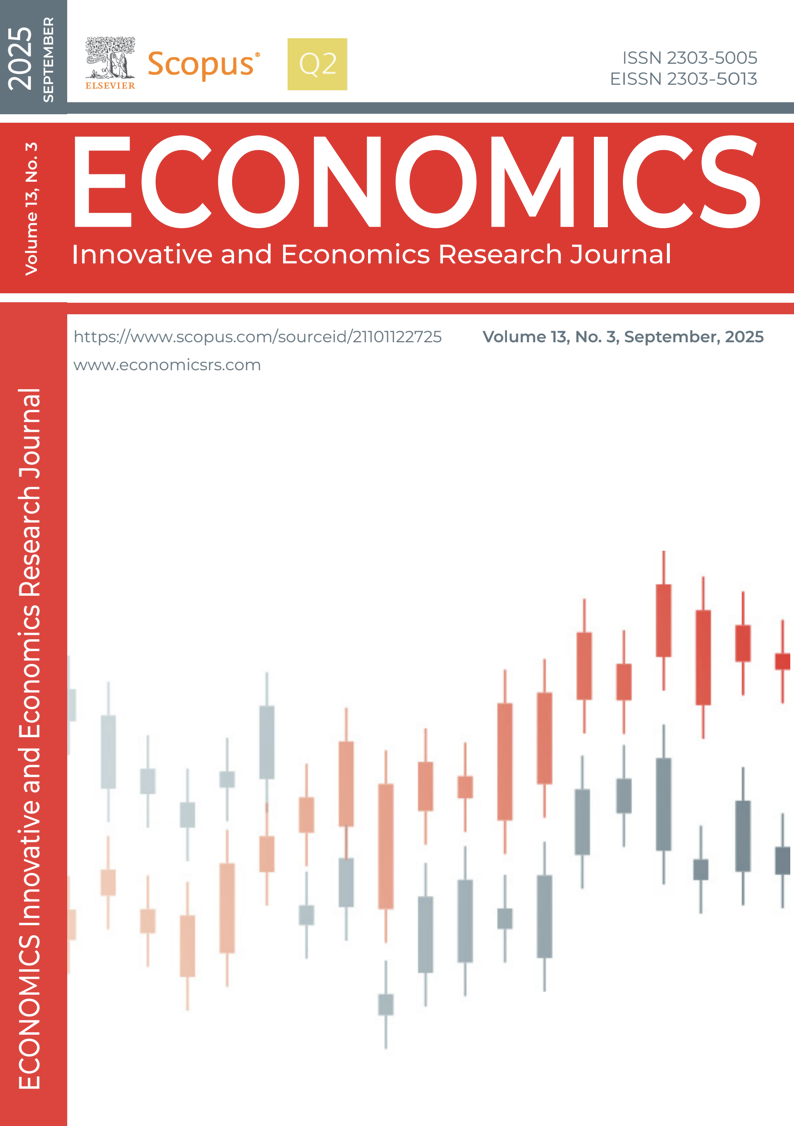IS THE STOCK MARKET A “BAROMETER” OF THE ECONOMY? BASED ON SOUTH AFRICA COMPREHENSIVE ANALYSIS
DOI:
https://doi.org/10.2478/eoik-2025-0072Keywords:
Stock Market, Barometer of the Economy, Cointegration, Vector Error Correction Model (VECM), South AfricaAbstract
An efficient stock market supports economic growth and is a barom-
eter of South Africa’s financial health. Our research delves into how
macroeconomic variables impact stock prices in South Africa by in-
vestigating yearly time series data ranging from 2000 to 2023. We
utilise Johansen’s cointegration test and the Vector Error Correction
Model (VECM) to investigate the equilibrium relationship between
stock market prices and critical macroeconomic factors like infla-
tion (INFL), trade rate (TR), money supply (MS) and exchange rate
(EXCH). The study findings indicate that these factors are correlated
in the long run, indicating a lasting correlation between specific mac-
roeconomic indicators and stock market prices. Stock market prices
are affected positively by exchange rates and inflation, as well as by
the money supply; however, trade rates have a negative impact accord-
ing to the analysis of short-term financial dynamics, which suggests
that adjustments are made to reach a long-term equilibrium despite the
lesser immediate effects of macroeconomic factors. Granger causality
tests show that macroeconomic factors influence stock market prices
over long and short-term periods. This highlights the importance of
the stock market as an indicator of trends and signals potential shifts
in the broader economy, which policymakers and investors should
keep a close eye on as an early warning system.
References
Anigbogu, U. E., & Nduka, E. K. (2014). Stock Market Performance and Economic Growth: Evidence
from Nigeria Employing Vector Error Correction Model Framework. The Economics and Fi-
nance Letters, 1(4), 90–103. https://doi.org/10.18488/journal.29/2014.1.9/29.4.90.103
Arjoon, R., Botes, M., Chesang, L. K., & Gupta, R. (2012). The long-run relationship between inflation
and real stock prices: Empirical evidence from South Africa. Journal of Business Economics
and Management, 13(4), 600–613. https://doi.org/10.3846/16111699.2011.620162
Aydemir, O., & Demirhan, E. (2009). The relationship between stock prices and exchange rates evi-
dence from turkey. International Research Journal of Finance and Economics, 1(23), 207–215.
https://doi.org/10.1007/bf02296425
Bhargave, H., & Tandon, D. (2023). How Does Tobin’S Q Respond To Merger and Acquisition An-
nouncements: Evidence of Listed Indian Firms. International Journal of Professional Business
Review, 8(2), 1–18. https://doi.org/10.26668/businessreview/2023.v8i2.1295
Bhowmik, R., & Wang, S. (2020). Stock market volatility and return analysis: A systematic literature
review. Entropy, 22(5), 1–18. https://doi.org/10.3390/E22050522
Bhuiyan, E. M., & Chowdhury, M. (2020). Macroeconomic variables and stock market indices: Asym-
metric dynamics in the US and Canada. Quarterly Review of Economics and Finance, 77, 62–
https://doi.org/10.1016/j.qref.2019.10.005
Bird, R., Menzies, G., Dixon, P., & Rimmer, M. (2011). The economic costs of US stock mispricing.
Journal of Policy Modeling, 33(4), 552–567. https://doi.org/10.1016/j.jpolmod.2010.10.010
Brown, J. R., Martinsson, G., & Petersen, B. C. (2017). Stock markets, credit markets, and technology-led
growth. Journal of Financial Intermediation, 32, 45–59. https://doi.org/10.1016/j.jfi.2016.07.002
Chen-Roll-Ross. (1993). Multifacotr Model. Journal of Empirical Finance, 13(2), 129–144.
Chinzara, Z. (2011). Macroeconomic uncertainty and conditional stock market volatility in South
Africa. South African Journal of Economics, 79(1), 27–49. https://doi.org/10.1111/j.1813-
2011.01262.x
Danso, E. I. (2020). Assessing the Impact of Macroeconomic Variables on the Performance of the As-
sessing the Impact of Macroeconomic Variables on the Performance of the U . S . Stock Market.
August. https://doi.org/10.7176/RJFA/11-14-08
Engle, R. F., & Granger, C. W. J. (2015). Co-integration and error correction: Representation, estima-
tion, and testing. Applied Econometrics, 39(3), 107–135. https://doi.org/10.2307/1913236
Gay, Jr., R. D. (2011). Effect Of Macroeconomic Variables On Stock Market Returns For Four Emerging
Economies: Brazil, Russia, India, And China. International Business & Economics Research
Journal (IBER), 7(3), 1–8. https://doi.org/10.19030/iber.v7i3.3229
Girardin, E., & Joyeux, R. (2013). Macro fundamentals as a source of stock market volatility in China:
A GARCH-MIDAS approach. Economic Modelling, 34, 59–68. https://doi.org/10.1016/j.econ-
mod.2012.12.001
Greenwood, R., & Scharfstein, D. (2013). The growth of finance. Journal of Economic Perspectives,
(2), 3–28. https://doi.org/10.1257/jep.27.2.3
Guei, K. M., & Choga, I. (2022). Exchange rate volatility and regional trade agreements in Southern Africa.
Economic Change and Restructuring, 55(2), 635–652. https://doi.org/10.1007/s10644-021-09323-x
Hamzah, M. A. (2005). Relationship between Macroeconomic Variables and Stock Market Indices:
Cointegration Evidence from Stock Exchange of Singapore’s All-S Sector Indices. Jurnal Pen-
gurusan, 24, 47–77. https://doi.org/10.17576/pengurusan-2005-24-03
Hendricks, K. B., Jacobs, B. W., & Singhal, V. R. (2020). Stock market reaction to supply chain dis-
ruptions from the 2011 great east japan earthquake. In Manufacturing and Service Operations
Management, 22(4). https://doi.org/10.1287/msom.2019.0777
Bimenyimana J. C. et al. / Economics - Innovative and Economics Research Journal, doi: 10.2478/eoik-2025-0072
Hendricks, K. B., & Singhal, V. R. (2014). The effect of demand-supply mismatches on firm risk. Pro-
duction and Operations Management, 23(12), 2137–2151. https://doi.org/10.1111/poms.12084
Ho, S. Y. (2019). Macroeconomic determinants of stock market development in South Africa. Internation-
al Journal of Emerging Markets, 14(2), 322–342. https://doi.org/10.1108/IJoEM-09-2017-0341
Hou, H., & Cheng, S. Y. (2010). The roles of stock market in the finance-growth nexus: Time series
cointegration and causality evidence from Taiwan. Applied Financial Economics, 20(12), 975–
https://doi.org/10.1080/09603101003724331
Imhanzenobe, J. O. (2023). Historical Development Of Frontier Stock Markets In Sub-Saharan Article
history: Keywords: Stock Market Development; Frontier Market; Adaptive Market Hypothesis;
Stock Market Reforms. Historical Development of Frontier Stock Markets in Sub-Saharan A.
–23. https://doi.org/10.26668/businessreview/2023.v8i7.2659
John, E. I. (2020). Money Supply and Stock Market Performance in Nigeria, South Africa and Ghana.
African Journal of Accounting and Financial Research, 3(1), 101–114. www.abjournals.org
Karanasos, M., Yfanti, S., & Hunter, J. (2022). Emerging stock market volatility and economic fun-
damentals: the importance of US uncertainty spillovers, financial and health crises. Annals of
Operations Research, 313(2), 1077–1116. https://doi.org/10.1007/s10479-021-04042-y
Karki, D., Bhattarai, G., & Khadka, P. B. (2023). Nature and Dynamics of Stock Market: A Bibliomet-
ric Analysis of its Development and Operations as an Economic Agency. NCC Journal, 8(1),
–98. https://doi.org/10.3126/nccj.v8i1.63672
Knio, M. S. E. D., & Houmani, H. (2024). Examining the impact of the stock market development on
Economic growth- KSA Tadawul. Emirati Journal of Business, Economics, & Social Studies,
(1), 104–120. https://doi.org/10.54878/73kwtm34
Korkmaz, Ö. (2020). The relationship between housing prices and inflation rate in Turkey: Evidence
from panel Konya causality test. International Journal of Housing Markets and Analysis, 13(3),
–452. https://ideas.repec.org/a/eme/ijhmap/ijhma-05-2019-0051.html
Mallika, J. K., & Randeni, R. K. D. (2022). “The Study on the Impact of Capital Market on Econom-
ic Growth in Sri Lanka “. International Journal of Research Publication and Reviews, 3(11),
–1922. https://doi.org/10.55248/gengpi.2022.3.11.26
Masoud, N., & Hardaker, G. (2012). The impact of financial development on economic growth: Empir-
ical analysis of emerging market countries. Studies in Economics and Finance, 29(3), 148–173.
https://doi.org/10.1108/10867371211246830
MW, & Enders, W. (1995). Applied Econometric Time Series. Journal of the American Statistical Asso-
ciation, 90(431), 1135. https://doi.org/10.2307/2291367
Ntshangase, K., Mingiri, K. F., & Palesa, M. M. (2016). The Interaction between the Stock Market and
Macroeconomic Policy Variables in South Africa. Journal of Economics, 7(1), 1–20. https://doi.
org/10.1080/09765239.2016.11907815
Okere, K. I., Muoneke, O. B., & Onuoha, F. C. (2021). Symmetric and asymmetric effects of crude oil
price and exchange rate on stock market performance in Nigeria: Evidence from multiple struc-
tural break and NARDL analysis. Journal of International Trade and Economic Development,
(6), 930–956. https://doi.org/10.1080/09638199.2021.1918223
Omar, A. Bin, Ali, A., Mouneer, S., Kouser, R., & Al-Faryan, M. A. S. (2022). Is stock market devel-
opment sensitive to macroeconomic indicators? A fresh evidence using ARDL bounds testing
approach. PLoS ONE, 17(10 October), 1–19. https://doi.org/10.1371/journal.pone.0275708
Panagiotidis, P. A. and T. (2012). Can common stocks provide hedge against inflation? Evidence from
SAARC countries. Pakistan Development Review, 4(51), 435–447. https://doi.org/10.30541/
v51i4iipp.435-448
Parasuraman & Ramudu, 2011). (2011). Historical and implied volatility: an investigation into Nse Nif-
ty futures and options. Australian Journal of Business and Management Research, 1(7), 112.,
(9), 167–169. https://www.ajbmr.com/articlepdf/ajbmr_17_34i1n7a12.pdf
Is the Stock Market a “Barometer” of the Economy? Based on South Africa Comprehensive Analysis
Ross, S. A. (1976). The arbitrage theory of capital asset pricing (Working Paper Version). Journal of
Economic Theory, 13(3), 341–360. https://doi.org/10.1142/9789814417358_0001
Sachdeva, T., Bhullar, P. S., & Gupta, P. K. (2021). Cointegration of Indian stock market with global stock
markets: An empirical analysis applying vector error correction model. SCMS Journal of Indian
Management, 18(3), 5–15. https://research.ebsco.com/c/edtm46/search/details/zodvhdjefb?db=bsu
Schwartz. (1999). Market Design and Information Economics. May. http://purl.stanford.edu/bm524fh7508
Shawtari, F. A., Salem, M. A., Hussain, H. I., Hawariyuni, W., & Thabet Omer, A. (2016). Long run rela-
tionship between macroeconomic indicators and stock price: The case of South Africa. Journal
of Internet Banking and Commerce, 21(September). https://doi.org/10.4172/1204-5357.s2-007
Silva, A., & Antunes, C. (2015). Multi-relational pattern mining over data streams. Data Mining and
Knowledge Discovery, 29(6), 1783–1814. https://doi.org/10.1007/s10618-014-0394-6
Suroso, S., Rusiadi, Purba, R. B., Siahaan, A. P. U., Sari, A. K., Novalina, A., & Lubis, A. I. F. (2018).
Autoregression vector prediction on banking stock return using capm model approach and
multi-factor apt. International Journal of Civil Engineering and Technology, 9(9), 1093–1103.
https://www.researchgate.net/publication/328029500_Autoregression_Vector_Prediction_on_
Banking_Stock_Return_using_CAPM_Model_Approach_and_Multi-Factor_APT_IJCIET
Verma, R. K., & Bansal, R. (2021). Impact of macroeconomic variables on the performance of stock
exchange: a systematic review. International Journal of Emerging Markets, 16(7), 1291–1329.
https://doi.org/10.1108/IJOEM-11-2019-0993
Wang, R., & Li, L. (2020). Dynamic relationship between the stock market and macroeconomy in China
(1995–2018): new evidence from the continuous wavelet analysis. Economic Research-Ekon-
omska Istrazivanja, 33(1), 521–539. https://doi.org/10.1080/1331677X.2020.1716264
Wang, W., Su, C., & Duxbury, D. (2021). Investor sentiment and stock returns: Global evidence. Journal
of Empirical Finance, 63, 365–391. https://doi.org/10.1016/j.jempfin.2021.07.010
Wilkens, K., & Zhu, J. (2001). Portfolio Evaluation and Benchmark Selection. The Journal of Alterna-
tive Investments, 4(1), 9–19. https://doi.org/10.3905/jai.2001.319003
Yadav, M. P., Khera, A., & Mishra, N. (2022). Empirical Relationship Between Macroeconomic Vari-
ables and Stock Market: Evidence from India. Management and Labour Studies, 47(1), 119–
https://doi.org/10.1177/0258042X211053166
Yeap, S. Y., & Gan, P. T. (2017). a Conceptual Model of Stock Market Efficiency: Does Economic Un-
certainty Matter? Journal of Contemporary Issues and Thought, 7(August), 79–87. https://doi.
org/10.37134/jcit.vol7.8.2017
Younis, I., Longsheng, C., Basheer, M. F., & Joyo, A. S. (2020). Stock market comovements among
Asian emerging economies: A wavelet-based approach. PLoS ONE, 15(10), 1–23. https://doi.
org/10.1371/journal.pone.0240472
Yussuf, Y. C. (2022). Cointegration test for the long-run economic relationships of East Africa commu-
nity: evidence from a meta-analysis. Asian Journal of Economics and Banking, 6(3), 314–336.
https://doi.org/10.1108/ajeb-03-2021-0032
Zolfaghari, M., & Sahabi, B. (2021). The impact of oil price and exchange rate on momentum strategy
profits in stock market: evidence from oil-rich developing countries. In Review of Managerial
Science, 15(7). Springer Berlin Heidelberg. https://doi.org/10.1007/s11846-020-00413-0
Downloads
Published
How to Cite
Issue
Section
License
Copyright (c) 2025 ECONOMICS - INNOVATIVE AND ECONOMICS RESEARCH JOURNAL

This work is licensed under a Creative Commons Attribution-NonCommercial-NoDerivatives 4.0 International License.























